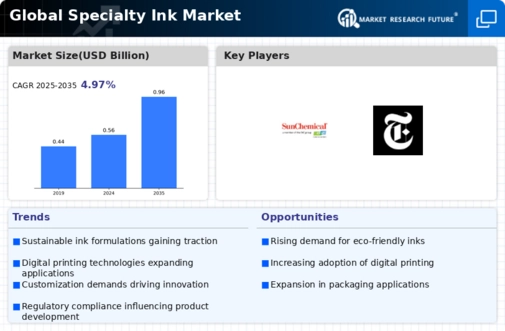Market Share
Specialty Ink Market Share Analysis
In the Specialty Ink Market, companies employ a range of market share positioning strategies to carve out a distinctive space in a competitive industry. With applications spanning from packaging to textiles, the specialty ink sector requires strategic initiatives that focus on innovation, customization, and effective market communication.
Innovative Product Development: Companies in the specialty ink sector prioritize innovation in their product offerings. Investing in research and development allows them to create inks with unique properties, such as enhanced color vibrancy, special effects, or compatibility with specific printing technologies. Innovation becomes a key differentiator in a market where the visual appeal and functionality of inks play a crucial role.
Customization for Diverse Applications: Recognizing the diverse applications of specialty inks in areas like packaging, textiles, and electronics, companies often tailor their products to meet specific industry needs. Customizing inks for different substrates and printing methods ensures relevance and attractiveness to targeted customer segments.
Strategic Partnerships and Alliances: Collaborative efforts with suppliers, printers, or industry partners are common strategies. Forming strategic alliances can lead to shared resources, access to new technologies, and collaborative marketing efforts, strengthening a company's market position.
Global Market Expansion: Companies explore opportunities for global expansion to tap into new markets and diversify their customer base. Expanding operations internationally not only broadens market reach but also allows companies to adapt to diverse cultural preferences and regulatory landscapes.
Sustainability and Eco-Friendly Inks: With a growing emphasis on sustainability, companies in the specialty ink market are increasingly focusing on eco-friendly solutions. Developing inks with reduced environmental impact, such as water-based or UV-curable inks, can appeal to environmentally conscious customers and align with market trends.
Brand Building and Marketing: Establishing a strong brand presence is crucial for market positioning. Effective branding, marketing campaigns, and communication strategies help create awareness about specialty ink products, build customer trust, and differentiate companies in a visually-driven market.
Technological Advancements and Digital Printing: Staying at the forefront of technological advancements is imperative. Companies that invest in digital printing technologies and innovative manufacturing processes can gain a competitive edge, offering faster turnaround times, customization options, and meeting the evolving needs of the market.
Customer Relationship Management (CRM): Building and maintaining strong relationships with customers are essential. Excellent customer service, technical support, and proactive engagement contribute to customer satisfaction, fostering loyalty and repeat business.
Regulatory Compliance: Adhering to industry regulations and safety standards is fundamental. Companies that prioritize compliance demonstrate a commitment to product quality, safety, and regulatory responsibility, building trust with customers and regulatory authorities.
Cost Efficiency and Competitive Pricing: Some companies adopt a cost leadership strategy by focusing on operational efficiency and cost-effective production processes. Offering specialty inks at competitive prices can attract a broader customer base and secure a significant share of the market.






Leave a Comment